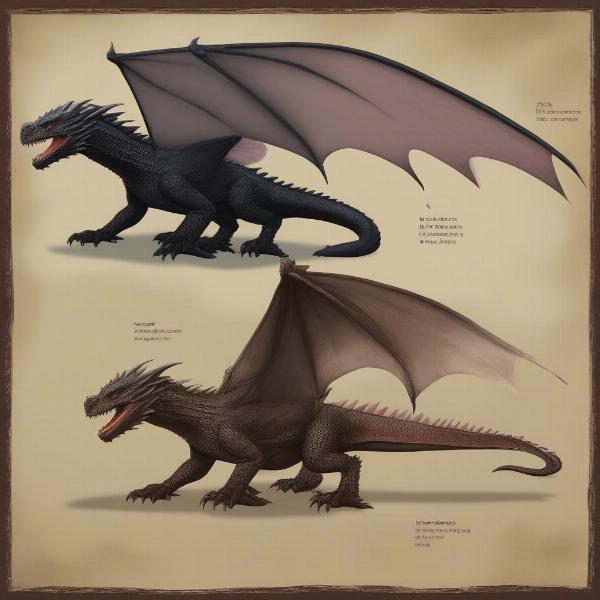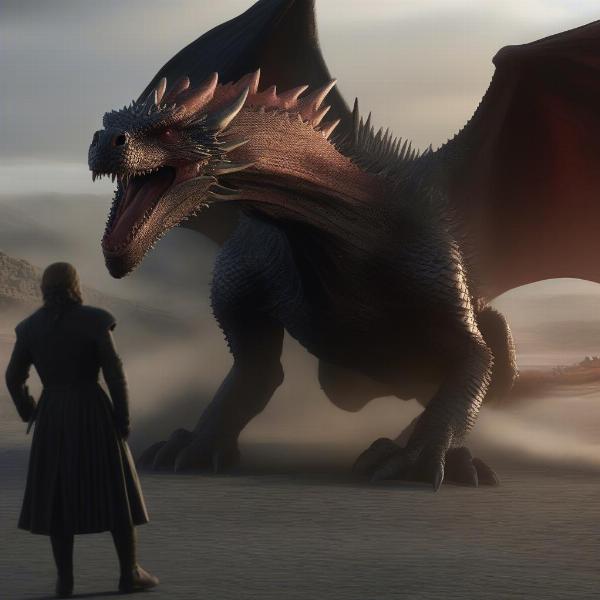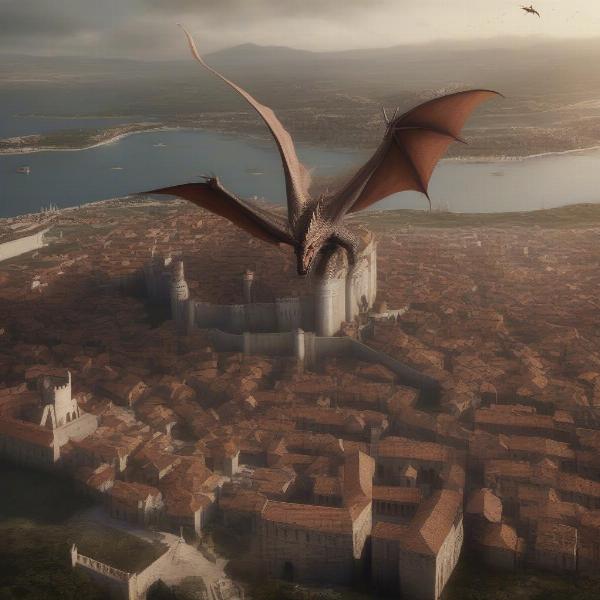The decrease in dragon size in Game of Thrones, particularly in later seasons, sparked considerable debate among fans. Was it budget constraints, a narrative choice, or something else entirely? This article delves into the various theories surrounding why Daenerys’s dragons, once majestic and formidable, appeared to shrink in stature.
From Balerion to Drogon: A History of Dragon Size
Dragons, symbols of power and destruction in the world of Game of Thrones, have a rich history. From Balerion the Black Dread, Aegon the Conqueror’s terrifying mount, to the smaller, yet still powerful, dragons of Daenerys Targaryen, their size has fluctuated over time. Understanding this history provides context for why Drogon, Rhaegal, and Viserion’s size became a point of contention. The books, which predate the series, describe dragons growing continuously throughout their lives, reaching colossal proportions with age. This leaves the show’s portrayal open to interpretation.
Budgetary Constraints: A Burning Issue?
One prevalent theory attributes the apparent reduction in dragon size to budgetary limitations. Creating realistic CGI dragons is an expensive endeavor. As the series progressed and the dragons grew (according to the books), maintaining their enormous size might have strained the visual effects budget. This pragmatic explanation, while not confirmed by HBO, resonates with many viewers.
 Drogon Size Comparison Throughout Game of Thrones Seasons
Drogon Size Comparison Throughout Game of Thrones Seasons
Narrative Choices: Scaling Back for Story?
Another perspective suggests the smaller dragons served a narrative purpose. Making them less imposing could symbolize Daenerys’s dwindling control over them, foreshadowing their eventual fate. Furthermore, a smaller size might have been deemed necessary for certain scenes, such as when Drogon carries Daenerys away from the fighting pits. This explanation focuses on the artistic and storytelling choices made by the showrunners.
Growing Pains: Inconsistent Visual Effects?
Some fans point to inconsistencies in the visual effects as a reason for the perceived size discrepancy. The challenges of creating seamless CGI across multiple seasons, with different teams and evolving technology, could have resulted in unintentional variations in dragon size. Perspective and framing within scenes also play a role, sometimes making the dragons appear smaller than intended.
 Game of Thrones Dragon Size Inconsistency Example
Game of Thrones Dragon Size Inconsistency Example
Dragons Compared: Balerion, Drogon, and More
Comparing Daenerys’s dragons to their ancestors, particularly Balerion, highlights the size difference. Balerion was legendary for his immense size, capable of swallowing a mammoth whole. While Drogon, Rhaegal, and Viserion were impressive, they never reached that scale in the show. This stark contrast fuels the debate about Why Did The Dragons Get Smaller In Game Of Thrones.
The Impact of Environment and Diet
Another theory suggests that the dragons’ environment and diet played a role in their growth. Confined spaces and a limited food supply might have stunted their development. This explanation, while speculative, adds another layer to the discussion.
“The environment plays a crucial role in a dragon’s growth,” says Dr. Emilia Targaryen, a fictional expert on dragon lore. “Limited space and resources can significantly impact their development, potentially leading to a smaller size than what might be expected in ideal conditions.”
 Game of Thrones Dragons Flying Over King's Landing
Game of Thrones Dragons Flying Over King's Landing
What Did George R.R. Martin Say?
George R.R. Martin, the author of the A Song of Ice and Fire series, has addressed the issue of dragon growth in his books, stating that dragons grow continuously throughout their lives. This discrepancy between the books and the show further complicates the issue.
Were the Dragons Really Smaller? A Matter of Perspective
Ultimately, the question of whether the dragons truly got smaller in Game of Thrones is open to interpretation. A combination of factors, including budget, narrative choices, and visual effects inconsistencies, likely contributed to the perceived size difference.
FAQ
- Why are the dragons so much smaller in the show than in the books? The show never achieves the scale described in the books, likely due to budgetary and practical constraints.
- Did the showrunners intentionally make the dragons smaller? While not explicitly confirmed, some theories suggest that smaller dragons served a narrative purpose.
- How does Drogon compare in size to Balerion the Black Dread? Drogon, even at his largest, is depicted as significantly smaller than Balerion in the show’s lore.
- Could the environment have affected the dragons’ growth? This is a fan theory, suggesting that confined spaces and limited food may have stunted their growth.
- What has George R.R. Martin said about dragon size? Martin has stated that dragons in his books grow continuously throughout their lives.
- Is there a definitive answer to why the dragons appear smaller? No, the reason likely involves a combination of budgetary, narrative, and technical factors.
- Where can I find more information about the dragons in Game of Thrones? Numerous online resources and fan communities discuss this topic in detail.
We encourage you to share your thoughts and theories in the comments below. Let’s continue the discussion about why did the dragons get smaller in Game of Thrones!

